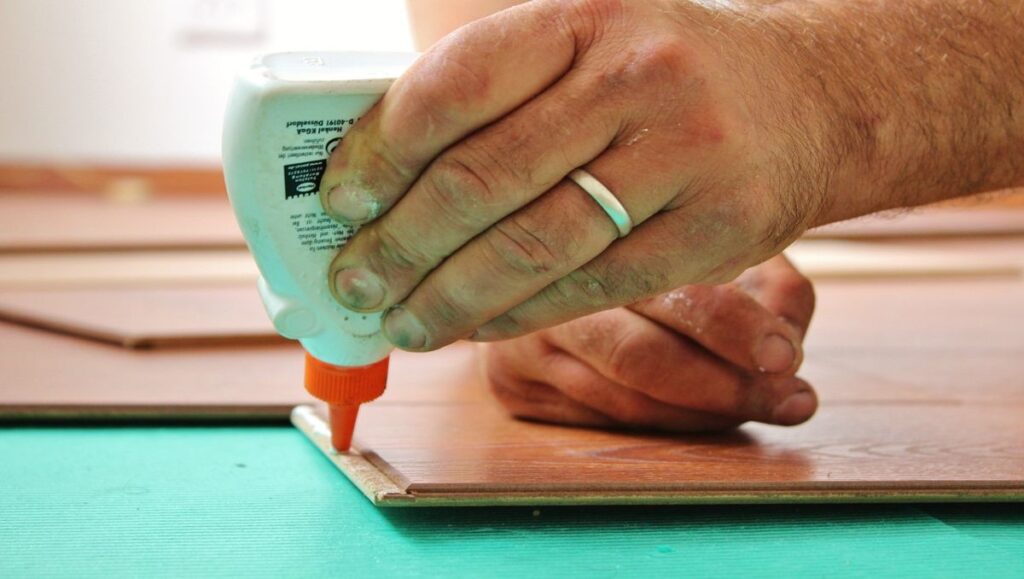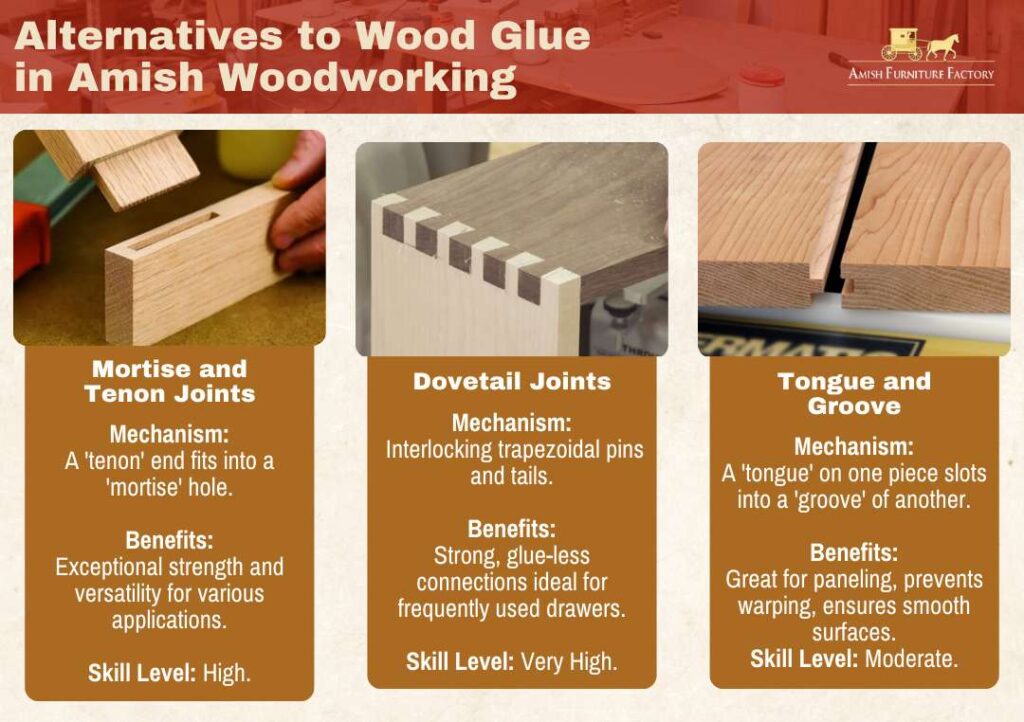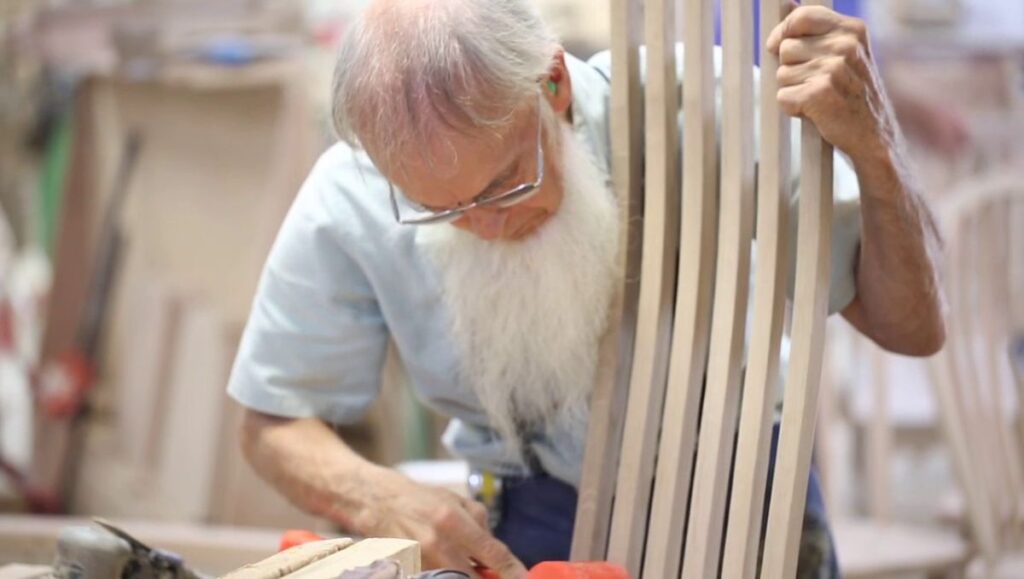
In the quiet workshops of Amish country, woodworking is more than a craft—it’s a heritage deeply rooted in every saw stroke and chisel mark. Here, the fusion of tradition and skill shapes not just wood but a philosophy of durability and artistry.
Amish woodworkers skillfully blend tradition with innovation, using wood glue to enhance their work’s durability. The choice between synthetic PVA for strength and natural hide glue for its eco-friendly qualities underscores their dedication to quality and environmental stewardship.
Discover how Amish artisans skillfully marry age-old traditions with selective modern practices, revealing a profound respect for craftsmanship and the environment. Let’s delve deeper into their world, understanding the pivotal role of wood glue in their timeless creations.
Understanding Amish Woodworking
Amish woodworking is not just about making something to use; it’s about crafting pieces that tell a story and last for generations.
Traditional Tools and Techniques
Amish woodworkers are renowned for using traditional tools and techniques passed down through the ages.
- Chisels: Used for carving and shaping wood, chisels allow Amish artisans to create intricate details and smooth finishes by hand. This tool is essential for joinery work, such as dovetails or mortise and tenon joints, showcasing the craftsman’s skill.
- Hand Planes: A fundamental tool for smoothing and flattening wooden surfaces. Hand planes are utilized to achieve a refined finish that machine planing often cannot match, providing a personal touch to each piece.
- Saws: Various types of saws, including crosscut and rip saws, are used to cut wood along and across the grain, respectively. Amish woodworkers choose saws based on the specific needs of their project, ensuring precision and efficiency.
- Hand Drills: Hand drills are preferred for creating holes without wood splitting. They offer control over the drilling speed and depth, which is crucial for maintaining the integrity of the wood in delicate operations.
- Wooden Mallets: Wooden mallets are used with chisels for carving and shaping. The mallet allows for controlled strikes, enabling detailed work without damaging the tool or workpiece.
- Measuring Tools: Precision is critical in Amish woodworking, so tools like rulers, tape measures, and squares are indispensable for ensuring accuracy in every cut and joint.
Craftsmanship and Quality
The hallmark of Amish woodworking is its unwavering focus on craftsmanship and quality. Every piece of furniture is made with care, often using wood from local sources, which ensures a connection between the material and the maker.
This dedication to excellence means that Amish-made furniture is functional and a work of art designed to be used and appreciated for many years.
The Use of Wood Glue in Amish Furniture Making
Amish artisans selectively apply wood glue in areas where it can improve the structural integrity of the furniture without compromising the traditional aesthetic. This careful application ensures that the finished product can withstand the test of time, embodying both form and function.
Types of Wood Glue Used in Amish Furniture
The different kinds of wood glue that Amish craftsmen use really show how they blend the old with the new in woodworking. They’ve got a unique way of sticking to their traditions while still being open to using modern stuff when it makes sense.

Traditional PVA Glues
Polyvinyl acetate (PVA) glue is a synthetic adhesive known for its strong bond and ease of use, making it a popular choice in many woodworking projects, including those undertaken by some Amish woodworkers.
PVA glue is valued for its versatility and can be used in a variety of applications, from joining wood pieces to sealing porous materials. It dries clear, does not emit strong odors, and is non-toxic, aligning with the Amish commitment to maintaining a healthy, simple lifestyle. However, its use is carefully considered, with a preference for types that are more environmentally friendly and less reliant on chemical formulations.
Hide Glues
Hide glue, made from rendered animal collagen, has a long history in woodworking and is favored in Amish communities for its natural composition and traditional pedigree. This type of glue is especially appreciated for its reversibility, allowing for the disassembly and repair of furniture without damaging the wood.
This feature is particularly valued in furniture restoration or when creating heirloom pieces meant to last for generations. Hide glue requires heating before application and has a limited open time, which necessitates a high skill level and understanding of the material, traits that Amish craftsmen possess in abundance.
Epoxy Resins
Epoxy resins are used by some Amish woodworkers for their unparalleled strength and durability, particularly in situations where the wood will be exposed to moisture or requires a bond stronger than what traditional glues can provide.
Epoxy is a two-part system, consisting of a resin and a hardener, that when mixed together, creates a chemical reaction leading to a hard, durable bond. While not traditional, its use in Amish woodworking is a testament to the pragmatic aspect of their craft, where the longevity and functionality of a piece can justify the selective incorporation of modern materials.
The choice of glue in Amish woodworking is dictated by a combination of factors, including the specific requirements of the project at hand, the desired aesthetics, and the long-term durability of the join.
Water resistance is a critical factor, especially for items that will be used outdoors or in damp environments. The bonding strength required also influences the choice; while PVA and hide glues are sufficient for many applications, the superior strength of epoxy may be necessary for structural elements or repairs.
The strategic use of wood glue in Amish woodworking contributes significantly to the longevity of the furniture. By reinforcing joints with glue, Amish artisans ensure that each piece is aesthetically pleasing and structurally sound. This meticulous attention to detail sets Amish-made furniture apart.
Alternatives to Wood Glue in Amish Woodworking

Traditional Joinery Methods
Traditional joinery techniques, honed over centuries, leverage the natural properties of wood to create durable and strong connections without relying on modern adhesives. Let’s delve deeper into these methods and their significance in Amish woodworking.
Mortise and Tenon Joints
This involves creating a ‘tenon’ (a protruding end of wood) that fits snugly into a corresponding ‘mortise’ hole in another piece of wood. Known for its incredible strength and reliability, the mortise and tenon joint is a testament to precision and skill in woodworking. It’s used in a variety of applications, from furniture to building frames, because of its ability to withstand shear and tensile forces. Crafting a perfect mortise and tenon joint requires precise measurements and cuts.
Dovetail Joints
Characterized by interlocking pins and tails with a trapezoidal shape, dovetail joints are most commonly used in drawer construction. The design of a dovetail joint ensures a strong connection that is difficult to pull apart, making it ideal for drawers that are frequently opened and closed. The mechanical strength of this joint means that it often doesn’t require glue to maintain its integrity. Dovetail joints are complex and require a high level of craftsmanship to create a tight, seamless fit.
Tongue and Groove
This joint consists of a protruding ‘tongue’ on one piece of wood that fits into a ‘groove’ cut into another piece. The tongue and groove method is excellent for creating large panels from smaller planks, such as in flooring, siding, and paneling. It provides a smooth, uniform surface and can help to restrict the movement of wood, preventing warping. While less complex than dovetail or mortise and tenon joints, precision is still required to ensure a snug fit.
Traditional vs. Modern Woodworking Techniques Among the Amish
In Amish woodworking, there’s a beautiful dance between honoring age-old traditions and embracing certain modern techniques that align with their core values. This careful selection ensures their furniture is not only of top-notch quality and sustainable but also true to their community’s principles.
Embracing Tradition in Woodworking
Amish craftsmen are deeply rooted in using traditional tools and methods, a practice handed down through generations. This dedication to the old ways is more than just sticking to what’s familiar; it’s about honoring their heritage and showcasing a commitment to exceptional craftsmanship and attention to detail. Working with these traditional tools fosters a unique connection to both the wood and the craft, a connection that’s often missing in today’s automated, machine-driven world.
Incorporating Modern Techniques
Yet, the Amish are not entirely closed off to modern innovations. Their approach to technology is thoughtful and deliberate, choosing to employ modern tools and materials that enhance their work without compromising their values. Steve Maxwell, known as “Canada’s Handiest Man,” notes the Amish’s thoughtful approach to technology, highlighting their use of cordless tools as an example of modern technology that fits within their guidelines.
Pneumatic tools, powered by air compressors, are one such modern adaptation. These tools offer efficiency and reliability without straying from the Amish commitment to simplicity and manual labor.
Benefits and Challenges of Using Wood Glue in Amish Woodworking

Introducing wood glue as a supplementary material to Amish woodworking brings significant advantages and notable challenges.
The Benefits
Integrating wood glue into Amish furniture brings many advantages, reinforcing the craftsmanship’s hallmark of durability, aesthetics, and structural integrity.
Increased Durability and Strength: Wood glue strengthens the bonds between wooden joints, significantly enhancing the furniture’s ability to withstand stress and usage over time. This is crucial for pieces intended to last for generations.
Improved Aesthetic Integrity: Wood glue that dries clear ensures that the natural beauty of the wood is not compromised. This allows for seamless joints that maintain the piece’s visual appeal without the distraction of visible adhesive.
Enhanced Structural Integrity: By reinforcing joints with glue, Amish artisans can ensure that each piece is functional and structurally sound. This meticulous attention to detail sets Amish-made furniture apart in quality and durability.
The Challenges
While wood glue offers numerous advantages to Amish woodworking, it also presents challenges that must be addressed.
Alignment with Sustainable Practices: Identifying glues that meet the Amish criteria for natural and sustainable materials can be challenging. The community’s commitment to the environment requires carefully selecting adhesives that do not compromise these values.
Balancing Tradition with Modern Materials: Integrating modern adhesives like wood glue into traditional woodworking practices poses a dilemma. Amish artisans must navigate the fine line between embracing innovation for improved durability and preserving the traditional methods that define their craft.
Maintaining Craftsmanship Standards: The introduction of any new material, including wood glue, requires skillful application to ensure it does not detract from the craftsmanship of the final piece. This includes training and adaptation among artisans to incorporate these materials without compromising the quality of their work.
Environmental Sustainability in Amish Woodworking
Amish woodworking deeply integrates environmental sustainability, reflecting their respect for nature through the thoughtful selection of materials and practices.
They prioritize locally sourced and reclaimed wood, reducing transportation emissions and waste. Their reliance on hand and pneumatic tools, alongside natural finishes and adhesives, underscores a commitment to minimizing energy consumption and ecological impact.
This approach ensures the longevity and durability of Amish furniture, aligning with their sustainable consumption philosophy and showcasing their dedication to preserving craftsmanship without compromising environmental integrity.
Amish Woodworking and Wood Glue: A Bond of Tradition
In the hands of the Amish, wood glue is more than just an adhesive; it’s a bridge between the enduring legacy of their craft and mindful modernity.
Their approach, blending deep-rooted traditions with selective innovations, mirrors a profound commitment to quality, sustainability, and the art of woodworking.
This exploration into Amish practices highlights their skillful craftsmanship. It inspires us to adopt a more intentional and respectful approach to our resources, echoing the Amish philosophy where every creation harmonizes with nature and tradition.
